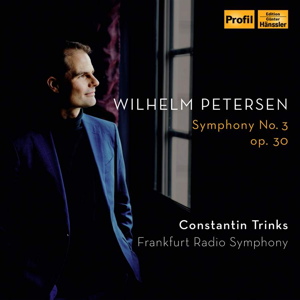
Wilhelm Petersen (1890-1957)
Symphony No. 3 in C sharp minor
Frankfurt Radio Symphony/Constantin Trinks
rec. 2021, Grosser Sendesaal Hessischen Rundfunks, Frankfurt, Germany
Profil PH22069 [60]
The booklet notes tell us that Wilhelm Petersen never gained recognition as a great composer because “he hadn’t moved with the times”. I’ve never heard of him before, and a Google search reveals next to nothing about him. He’s not even well-represented on CD, though my colleague Rob Barnett reviewed a disc of his lieder back in 2003 on the obscure Eigenart label. The only other recordings of his music I could find were a 2 CD set of his complete works for violin and piano (Coviello) and a disc of his Grosse Messe (Wergo).
Born in Athens, Petersen started off writing poetry, but later decided that music was to be his true vocation. He studied in Munich with Friedrich Klose, Felix Mottl and Rudolf Louis, and I was interested to read that between 1913 to 1914 he served as an apprentice conductor in Lübeck under Wilhelm Furtwängler. From 1927 he lectured in composition and harmony at the Music Academy in Darmstadt, and from 1934 taught in Mannheim.
As regards his music, he followed his own instincts and took a traditional path, shunning the avant-garde, though he did experiment with modern trends early in his career. His compositions include 5 symphonies, concertos, works for string orchestra, vocal, choral and chamber music. His opera Der goldene Topf was premiered in Mannheim, and his Grosse Messe, Op. 27 received its premiere in 1930 in Dartmstadt under the baton of Karl Böhm.
Only four of Petersen’s five symphonies were published in his lifetime. The Fifth, dating from 1934 was only discovered after his death and was first performed in 1959. The Third Symphony in C sharp minor was likewise composed in the early 1930s. It was premiered in 1934 in Darmstadt under the baton of Karl Friderich. It also received a performance a year later in Berlin, this time under Hermann Abendroth. It’s here receiving its World Recording Premiere.
At just over 24 minutes, the opening movement is the most substantial of the three. It’s Brucknerian in scale, which is hardly surprising as Petersen was an ardent devotee of the older composer. Whilst Bruckner hovers in the background, echoes of Mahler can be heard, especially in the fanfare opening. This trumpet call ushers in a sombre theme of elegiac flavour, both melancholic and doleful. It acts almost as an introduction to a more expansive section. Magisterial and monumental are adjectives that come to mind. Midway, there’s a more soothing section of bucolic charm, more poised and almost dreamy.
The slow movement is awash with sensuous lyricism. The mood is one of tenderness, intimacy, radiance and warmth. There are some alluring woodwind passages, which add colour to the canvas. The movement sounds very Brucknerian to me. The warmly moulded and essentially conciliatory mood persists throughout the 19 minute span of the music.
The finale is upbeat and optimistic in tone. Skilful counterpoint gives the music direction and forward momentum. Once again, Petersen proves himself to be an accomplished and imaginative orchestrator.
Constantin Trinks and the Frankfurt Radio Symphony give a performance truly worthy of this intriguing score, and they’ve been recorded in the best possible sound. I’m rather surprised that there are two photographs of the conductor in the booklet, yet none of the composer. One would have been most welcome. Let’s hope some of Petersen’s other symphonies will be recorded by this illustrious group.
Stephen Greenbank
Help us financially by purchasing from





















